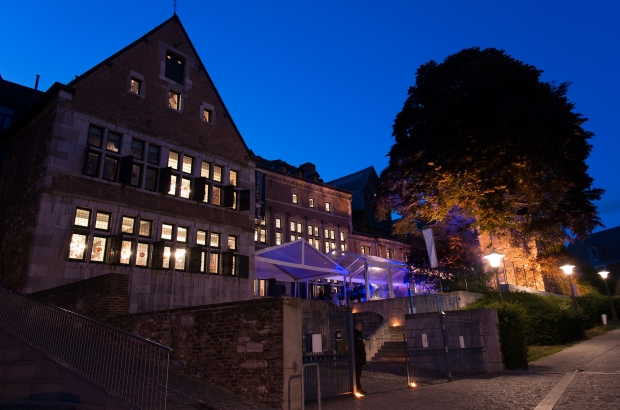- Daily & Weekly newsletters
- Buy & download The Bulletin
- Comment on our articles
The arts centre in Liège is the renaissance of a centuries-old building
Liège celebrated the grand opening of its newest contemporary arts space in 2014, but the Bocholtz isn’t ‘new’ at all. This meticulously restored 16th-century hôtel particulier, in Place Saint-Michel, just a stone’s throw from the city’s famous palace, has one foot in regional history and another in a resolutely international future, thanks to its enterprising new owner, François Fornieri of Liège-based pharmaceutical firm Mithra.
Fornieri bought the building in 2013 with the intention to restore it to its original architectural glory and repurpose the site altogether, to transform it from the private residence Hôtel de Bocholtz to the Bocholtz, Maison Internationale de Liège. Fornieri has created a space where locals can discover contemporary international artists. As 21st-century as all this talk of global culture sounds, the vision is entirely in keeping with that of the Bocholtz’s first master.
There’s a good reason why, architecturally, the Bocholtz fits right into the landscape of one of Wallonia’s most historic and scenic cities. The sumptuous house was built at the end of the Middle Ages by eponymous Dutch canon Arnold de Bocholtz, who settled in the insular Prince-Bishopric of Liège on ecclesiastical business. This man of the cloth was also a man of the world. Not content with the parochial, mostly gothic architectural values that dominated inward-looking Liège, Bocholtz sought to open the doors of his new parish to the rest of Europe, particularly Renaissance Italy. He led by an architectural example that was widely followed.
“The Hôtel de Bocholtz was one of the first buildings in Liège to incorporate the Italian style,” says Bocholtz artistic director Jean-Christophe Hubert. “It was a revolutionary gesture at the time and it would influence later developments around the city.”
This was a promising enough start but the intervening half-millennium hasn’t been kind to this pioneering piece of architecture. The structure was expanded and modified by succeeding generations of Bocholtzes until the house passed out of family hands in the late 17th century. By the 19th, it was old hat, even shabby. Derelict, this architectural milestone was in danger of demolition by modern developers.
The house that Bocholtz built was only spared the wrecking ball by a 1953 royal decree naming it a historical monument. Thence it was bought by a succession of banks who launched a seemingly interminable programme of restoration throughout the 1960s and 70s. It was Mithra founder and CEO Fornieri who would realise this prodigious task, decades later.
Fornieri acquired the place in 2013 and set to work at once to create his Maison Internationale de Liège. It was an idea, he figured, whose time had come. “Mr Fornieri conceived the Bocholtz as a space dedicated entirely to international arts,” Hubert says, “not local, not regional but international. This global dimension is something that has been lacking in Liège.”
With a crew of contractors already at work on the physical structure, it remained only to assemble a team of culture-sector professionals, including art historian Hubert, to fill the Bocholtz’s luxurious halls and chambers with contemporary art. This, too, was a process.
A few lucky, art-loving Liégeois got a partial glimpse of the new and improved Bocholtz before the official opening. While some rooms were still in the process of restoration, Bocholtz brass decided to test-drive the main exhibition rooms with a month-long, semi-private exhibition of works by Israeli artist David Gerstein. Anticipation mounted.
With work finally complete in every corner of the structure, Fornieri and his team definitively opened the Bocholtz to the public at the end of August 2014 with an homage to Belgian glassworker Louis Leloup. Although a Liège native, who got his start working for Belgian crystal and glassware brand Val Saint Lambert, Leloup has operated on the world stage as an independent artist for decades.
His greatest successes, for example, have been overseas. The local-boy-done-good has an entire museum dedicated to him in Kyoto, Japan. Established in 1997, the Musée Louis Leloup boasts three floors of Leloup originals, 600 works in total. Fifty of these were showcased at the Bocholtz for its official inaugural exhibition.
It was followed by L’Expérience du Mouvement which featured more than 100 works in various media by pioneering French Impressionists Edgar Degas, Auguste Rodin and Claude Monet. “This was a milestone for us at the Bocholtz,” Hubert says. “It was our first major public exhibition and, what’s more, the featured artists are legends. Degas and his peers were clear precursors of twentieth-century modern art. Their influence can still be felt today.”
The Impressionists’ contributions to contemporary artistic practice are indeed legion. They broke with tradition in matters of form and content. Bored with monumental Romantic tableaux of epic scenes drawn from history and mythology, Degas in particular found his inspiration in the daily life around him. He documented the mundane street scene, the horse race, the cafe, and he did so with kinetic verve. His seemingly hasty strokes suggested the constant movement of modern life, which, the Impressionists were the first to realise, was more than just a new experience; it was an entirely new way of experiencing the world.
This is a fitting manifesto for Fornieri and his new Maison Internationale de Liège, whose staff embrace this progressive, internationalist brand of modernity. But if their eyes are fixed forward, that doesn’t mean the Bocholtz is turning its back on a very substantial historical legacy. A guided tour of the entire building is available on request. This is a veritable voyage through time. Highlights include the creepy crypt, which has yet to be used for exhibition purposes. So the Bocholtz combines the best of old and new under one (ornate) roof.
This article was first published in the Wab magazine.


















